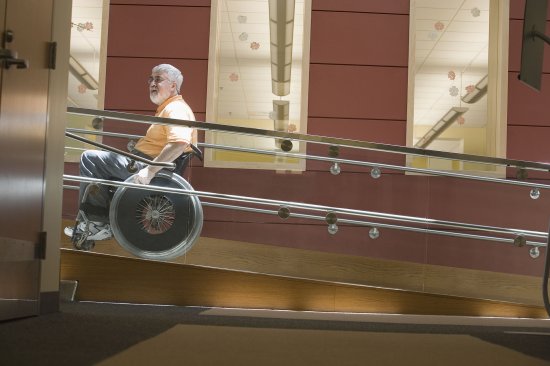Social distancing - it’s a term that never existed before, but one that we’re now all more than familiar with. But could it pave the way for better access for disabled people?

Up and down the country, shops, banks, factories, offices, bars, restaurants and cafes are making adjustments to their physical environments and layouts in accordance with social distancing guidelines – to make them safe and accessible for us – the general public, to visit.
The principles are in fact very similar to those aimed at improving accessibility for disabled people – making reasonable adjustments to a building or premises in line with best-practice standards – to remove barriers to access.
And many of the measures being adopted for social distancing are ones that disabled people have been demanding for years – wider pavements and store aisles, improving flow and reducing pinch points, clearer wayfinding and signage, as well as automatic doors/openings designed to minimise contact. As well as keeping us socially distant, they go some way to improving accessibility for all.
As businesses are taking these steps now to make changes to their physical environment and layout, it provides an ideal opportunity to review these with disabled users in mind too. If you’re looking at a pinch point in a doorway or corridor, there’s every chance that, as well as being a barrier to social distancing, it will also present difficulties for a wheelchair, crutch or frame user. Is there an alternative route and if so, is it accessible?
Removing clutter to widen aisles and improve flow is likely to create a more accessible environment, so businesses could consider keeping new layouts permanently. Likewise, any structural changes to layouts to accommodate social distancing can also be designed with accessibility in mind.
If new signage, hand washing and sanitation points are all being installed, are these designed and located with disabled users in mind? And if you are reducing the capacity of lifts, do you have a plan in place for disabled visitors and staff?
Despite movements to make society more accessible in recent years, there is still a long way to go. One global survey found that although 90% of businesses say they prioritise diversity, only 4% were working on becoming more inclusive for people with disabilities. In the UK, a 2018 study found that 75% of disabled people have had to leave a shop or business due to the lack of understanding or awareness of their needs, and a survey of 27,000 retail outlets found that 20% don’t provide access to wheelchair users.
We have completed over 6000 Disabled Access Audits on all kinds of premises across the UK and there are usually a range of simple and inexpensive measures that can be taken to improve accessibility. Just as we have been able to respond and adapt to social distancing guidelines, we can do the same for Disabled Access, it just takes a bit of thought and the commitment to do so.
As COVID-19 has forced businesses to become more aware of adapting their surroundings and taking adjustive steps, perhaps some lessons will be learned, it will become second nature and incorporating accessible standards will become part of the process too.
Ian Eggleton is Director of Access Consultancy at Evans Jones Ltd. and has carried out more than 6000 Disabled Access Audits, Disabled Access Statements and Access Appraisals across all manner of different buildings and environments.
If you would like a Disabled Access Audit carried out on your premises, contact Ian Eggleton on 0800 0014090 or email info@evansjones.co.uk
